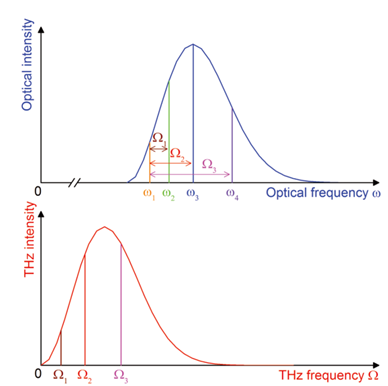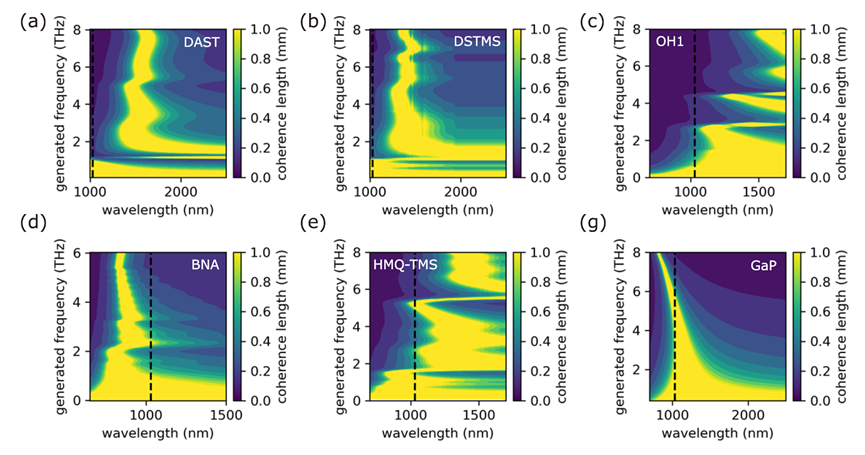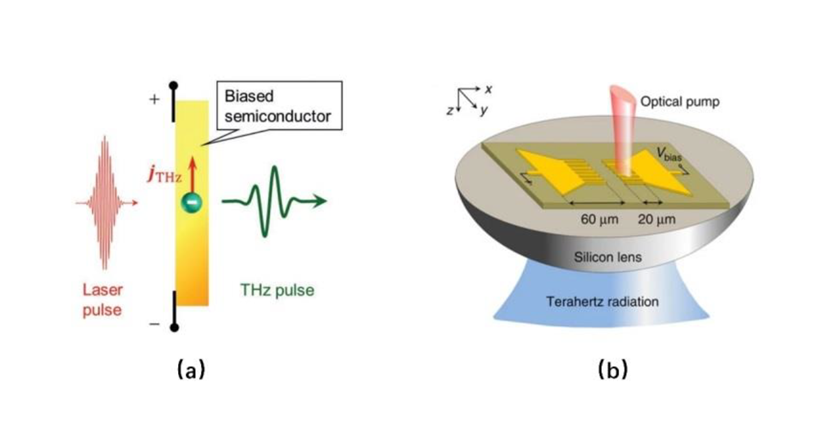Advances in Ultrafast Nonlinear Optical Technologies: Ultrafast Laser-Driven THz Sources
![]() 02/10 2025
02/10 2025
![]() 595
595
Terahertz waves (THz) occupy a unique position on the electromagnetic spectrum, bridging the gap between infrared and microwaves. With photon energies spanning 1-10 meV, THz waves exhibit a wide range of applications in spectral analysis, medical imaging, and mobile communications. THz generation typically relies on transient current radiation, and this article delves into three prevalent methods for generating these waves.
The first method is optical rectification, akin to frequency mixing. As illustrated in Figure 1, when the frequency difference of the pulse falls within the THz range, THz waves of varying frequencies can be produced. Femtosecond laser pulses, typically ranging from 10 fs to 10 ps, cover a spectral frequency difference of 0.1 - 100 THz. Crystals used for optical rectification are classified into organic and inorganic types. Inorganic crystals offer narrow phase-matching bandwidths but high damage thresholds, with current research focusing on power levels between 100 mW and 1 W below 5 THz. Conversely, organic crystals boast broad bandwidths and low damage thresholds, with powers ranging from 1 - 10 mW, capable of generating THz frequencies up to 10 THz, albeit with temperature sensitivity.

Figure 1: Principle of THz Generation by Difference Frequency [1]
In selecting a crystal, factors such as a large nonlinear coefficient, thicker crystal dimensions, low THz absorption coefficient, and suitable optical and THz frequency refractive indices contribute to higher THz generation efficiency. However, meeting all these criteria simultaneously in real materials is often challenging. Figure 2 outlines the phase matching conditions for six types of crystals. For instance, GAP exhibits a low absorption coefficient and high damage threshold but a small nonlinear coefficient, resulting in an efficiency of just 0.001%. LiNbO3 can achieve higher efficiency but requires wavefront tilting, adding complexity to the setup. Organic crystals, like BNA, offer large nonlinear coefficients with an efficiency of up to 0.1% but are temperature-sensitive and have low damage thresholds, typically handling powers less than 2 W [2].

Figure 2: Phase Matching Conditions for THz Excitation by Six Different Crystals [3]
The second common method for generating THz waves involves photoconductive antennas, as depicted in Figure 3. The basic structure comprises two metal electrodes on a semiconductor substrate. When a femtosecond laser illuminates the substrate material between the electrodes, transient photogenerated carriers are created on the semiconductor surface. These carriers, under the influence of an applied bias electric field, form a transient photocurrent, radiating THz electromagnetic wave pulses. Enhanced THz generation efficiency can be achieved through larger bias voltages and cross-electrode arrays (as shown in Figure 3).

Figure 3: Principle of THz Generation by Photoconductive Antennas
The third method revolves around laser-generated plasmas. Its primary advantage lies in its independence from the medium's damage threshold, enabling the use of high-power lasers for ultra-strong THz radiation. In 1993, Hamster et al. employed TW-level high-power lasers to ionize gas, generating plasmas that radiated THz waves. The introduction of the two-color field theory in 2000 significantly boosted THz radiation efficiency. Further research indicates that noble gases exhibit higher THz generation efficiency. THz radiation sources stemming from laser-plasma interactions can be differentiated based on the plasma-generating matter's state, including solids, liquids, and gases. Plasma density determines the intensity of generated THz; gas plasmas, with the lowest density, currently radiate a maximum THz energy of 0.185 mJ. Solids produce the strongest plasma density, with researchers achieving 55 mJ of THz through 60 J of ultra-strong laser pumping of metal films. However, intense laser irradiation can damage solid targets, leading to unstable plasma states and impeding stable THz generation. In contrast, gas targets, while offering lower plasma densities, ensure THz radiation stability through continuous gas replenishment. Liquid targets, offering higher densities and potential plasma stability improvements, serve as a compromise between gas and solid targets. Currently, liquids generate THz with an energy of only 0.08 mJ, and enhancing liquid target efficiency is a focus for future work.

Figure 4: THz Generation Results from Different Technologies [1]
With the rapid advancement of high-power femtosecond laser technology, the output energy of THz based on femtosecond laser pumping has steadily increased over the years (as shown in Figure 4), spanning from single-pulse energies in the nJ to μJ range and now reaching the mJ level, marking a six-order-of-magnitude crossover. Powers have also surged from mW to W levels. These technological advancements have significantly propelled the application of THz light sources.
References: [1] Fülöp J A, Tzortzakis S, Kampfrath T. Laser‐driven strong‐field terahertz sources[J]. Advanced Optical Materials, 2020, 8(3): 1900681. [2] Mansourzadeh S, Vogel T, Shalaby M, et al. Milliwatt average power, MHz-repetition rate, broadband THz generation in organic crystal BNA with diamond substrate[J]. Optics Express, 2021, 29(24): 38946-38957. [3] Mansourzadeh S, Vogel T, Omar A, et al. Towards intense ultra-broadband high repetition rate terahertz sources based on organic crystals[J]. Optical Materials Express, 2023, 13(11): 3287-3308. [4] Choi W J, Armstrong M, Yoo J H, et al. Toward high-power terahertz radiation sources based on ultrafast lasers[J]. Journal of Materials Chemistry C, 2024.








